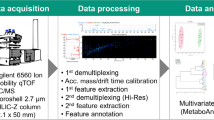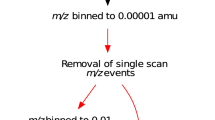Abstract
Due to the presence of pollutants in the environment and food, the assessment of human exposure is required. This necessitates high-throughput approaches enabling large-scale analysis and, as a consequence, the use of high-performance analytical instruments to obtain highly informative metabolomic profiles. In this study, direct introduction mass spectrometry (DIMS) was performed using a Fourier transform ion cyclotron resonance (FT-ICR) instrument equipped with a dynamically harmonized cell. Data quality was evaluated based on mass resolving power (RP), mass measurement accuracy, and ion intensity drifts from the repeated injections of quality control sample (QC) along the analytical process. The large DIMS data size entails the use of bioinformatic tools for the automatic selection of common ions found in all QC injections and for robustness assessment and correction of eventual technical drifts. RP values greater than 106 and mass measurement accuracy of lower than 1 ppm were obtained using broadband mode resulting in the detection of isotopic fine structure. Hence, a very accurate relative isotopic mass defect (RΔm) value was calculated. This reduces significantly the number of elemental composition (EC) candidates and greatly improves compound annotation. A very satisfactory estimate of repeatability of both peak intensity and mass measurement was demonstrated. Although, a non negligible ion intensity drift was observed for negative ion mode data, a normalization procedure was easily applied to correct this phenomenon. This study illustrates the performance and robustness of the dynamically harmonized FT-ICR cell to perform large-scale high-throughput metabolomic analyses in routine conditions.

Analytical performance of FT-ICR instrument equipped with a dynamically harmonized cell.




Similar content being viewed by others
References
Oikawa A, Nakamura Y, Ogura T, Kimura A, Suzuki H, Sakurai N, et al. Clarification of pathway-specific inhibition by Fourier transform ion cyclotron resonance/mass spectrometry-based metabolic phenotyping studies. Plant Physiol. 2006;142:398–413. https://doi.org/10.1104/pp.106.080317.
Ritchie SA, Ahiahonu PW, Jayasinghe D, Heath D, Liu J, Lu Y, et al. Reduced levels of hydroxylated, polyunsaturated ultra long-chain fatty acids in the serum of colorectal cancer patients: implications for early screening and detection. BMC Med. 2010;8:1–20. https://doi.org/10.1186/1741-7015-8-13.
Lucio M, Fekete A, Weigert C, Wägele B, Zhao X, Chen J, et al. Insulin sensitivity is reflected by characteristic metabolic fingerprints-a Fourier transform mass spectrometric non-targeted metabolomics approach. PLoS One. 2010;5:e13317. https://doi.org/10.1371/journal.pone.0013317.
Hughey CA, Rodgers RP, Marshall AG. Resolution of 11,000 compositionally distinct components in a single electrospray ionization Fourier transform ion cyclotron resonance mass spectrum of crude oil. Anal Chem. 2002;74:4145–9. https://doi.org/10.1021/ac020146b.
Habchi B, Alves S, Paris A, Rutledge DN, Rathahao-Paris E. How to really perform high throughput metabolomic analyses efficiently? TrAC Trends Anal Chem. 2016;85:128–39. https://doi.org/10.1016/j.trac.2016.09.005.
González-Domínguez R, Castilla-Quintero R, García-Barrera T, Gómez-Ariza JL. Development of a metabolomic approach based on urine samples and direct infusion mass spectrometry. Anal Biochem. 2014;465:20–7. https://doi.org/10.1016/j.ab.2014.07.016.
Marshall AG, Hendrickson CL, Jackson GS. Fourier transform ion cyclotron resonance mass spectrometry: a primer. Mass Spectrom Rev. 17:1–35.
Marshall AG. Milestones in Fourier transform ion cyclotron resonance mass spectrometry technique development. Int J Mass Spectrom 1998. 2000;200:331–56. https://doi.org/10.1016/S1387-3806(00)00324-9.
Marshall AG, Hendrickson CL. Fourier transform ion cyclotron resonance detection: principles and experimental configurations. Int J Mass Spectrom. 2002;215:59–75. https://doi.org/10.1016/S1387-3806(01)00588-7.
Boldin IA, Nikolaev EN. Fourier transform ion cyclotron resonance cell with dynamic harmonization of the electric field in the whole volume by shaping of the excitation and detection electrode assembly. Rapid Commun Mass Spectrom. 2011;25:122–6. https://doi.org/10.1002/rcm.4838.
Nikolaev EN, Boldin IA, Jertz R, Baykut G. Initial experimental characterization of a new ultra-high resolution FTICR cell with dynamic harmonization. J Am Soc Mass Spectrom. 2011;22:1125–33. https://doi.org/10.1007/s13361-011-0125-9.
Nikolaev E, Jertz R, Grigoryev A, Baykut G. Fine structure in isotopic peak distributions measured using a dynamically harmonized Fourier transform ion cyclotron resonance cell at 7 T. Anal Chem. 2012;84:2275–83. https://doi.org/10.1021/ac202804f.
Marshall AG, Blakney GT, Chen T, Kaiser NK, McKenna AM, Rodgers RP, et al. Mass resolution and mass accuracy: how much is enough? Mass Spectrom. 2013;2:S0009. https://doi.org/10.5702/massspectrometry.S0009.
Xian F, Hendrickson CL, Marshall AG. High resolution mass spectrometry. Anal Chem. 2012;84:708–19. https://doi.org/10.1021/ac203191t.
Thurman EM, Ferrer I. The isotopic mass defect: a tool for limiting molecular formulas by accurate mass. Anal Bioanal Chem. 2010;397:2807–16. https://doi.org/10.1007/s00216-010-3562-6.
Padilla-Sánchez JA, Plaza-Bolaños P, Romero-González R, Grande-Martínez Á, Thurman EM, Garrido-Frenich A. Innovative determination of polar organophosphonate pesticides based on high-resolution Orbitrap mass spectrometry. J Mass Spectrom. 2012;47:1458–65. https://doi.org/10.1002/jms.3107.
Rathahao-Paris E, Alves S, Junot C, Tabet J-C. High resolution mass spectrometry for structural identification of metabolites in metabolomics. Metabolomics. 2016;12:10. https://doi.org/10.1007/s11306-015-0882-8.
Romano S, Dittmar T, Bondarev V, Weber RJM, Viant MR, Schulz-Vogt HN. Exo-metabolome of Pseudovibrio sp. FO-BEG1 analyzed by ultra-high resolution mass spectrometry and the effect of phosphate limitation. PLoS One. 2014;9:1–11. https://doi.org/10.1371/journal.pone.0096038.
Jansson J, Willing B, Lucio M, Fekete A, Dicksved J, Halfvarson J, et al. Metabolomics reveals metabolic biomarkers of Crohn’s disease. PLoS One. 2009;4:e6386. https://doi.org/10.1371/journal.pone.0006386.
Han J, Danell RM, Patel JR, Gumerov DR, Scarlett CO, Speir JP, et al. Towards high-throughput metabolomics using ultrahigh-field Fourier transform ion cyclotron resonance mass spectrometry. Metabolomics. 2008;4:128–40. https://doi.org/10.1007/s11306-008-0104-8.
Rosselló-Mora R, Lucio M, Peña A, Brito-Echeverría J, López-López A, Valens-Vadell M, et al. Metabolic evidence for biogeographic isolation of the extremophilic bacterium Salinibacter ruber. ISME J. 2008;2:242–53. https://doi.org/10.1038/ismej.2007.93.
Kirwan JA, Broadhurst DI, Davidson RL, Viant MR. Characterising and correcting batch variation in an automated direct infusion mass spectrometry (DIMS) metabolomics workflow. Anal Bioanal Chem. 2013;405:5147–57. https://doi.org/10.1007/s00216-013-6856-7.
Taylor NS, Weber RJM, Southam AD, Payne TG, Hrydziuszko O, Arvanitis TN, et al. A new approach to toxicity testing in Daphnia Magna: application of high throughput FT-ICR mass spectrometry metabolomics. Metabolomics. 2009;5:44–58. https://doi.org/10.1007/s11306-008-0133-3.
Kirwan JA, Weber RJM, Broadhurst DI, Viant MR. Direct infusion mass spectrometry metabolomics dataset: a benchmark for data processing and quality control. Sci Data. 2014;1:1–27. https://doi.org/10.1038/sdata.2014.12.
Wehrens R, Hageman JA, van Eeuwijk F, Kooke R, Flood PJ, Wijnker E, Keurentjes JJB, Lommen A, van Eekelen HDLM, Hall RD, Mumm R, de Vos RCH. Improved batch correction in untargeted MS-based metabolomics. Metabolomics 2016;12. doi: https://doi.org/10.1007/s11306-016-1015-8.
Van Der Kloet FM, Bobeldijk I, Verheij ER, Jellema RH. Analytical error reduction using single point calibration for accurate and precise metabolomic phenotyping. J Proteome Res. 2009;8:5132–41. https://doi.org/10.1021/pr900499r.
Lin L, Yu Q, Yan X, Hang W, Zheng J, Xing J, et al. Direct infusion mass spectrometry or liquid chromatography mass spectrometry for human metabonomics? A serum metabonomic study of kidney cancer. R Soc Chem. 2010;135:2970–8. https://doi.org/10.1039/c0an00265h.
Gika HG, Theodoridis GA, Wingate JE, Wilson ID. Within-day reproducibility of an HPLC MS based method for Metabonomic analysis: application to human urine. J Proteome Res. 2007;6:3291–303. https://doi.org/10.1021/pr070183p.
Li B, Tang J, Yang Q, Li S, Cui X, Li Y, et al. NOREVA: Normalization and evaluation of MS-based metabolomics data. Nucleic Acids Res. 45:W162–70. https://doi.org/10.1093/nar/gkx449.
Qannari EM, Wakeling I, Courcoux P, MacFie HJH. Defining the underlying sensory dimensions. Food Qual Prefer. 2000;11:151–4. https://doi.org/10.1016/S0950-3293(99)00069-5.
Dubin E, Spiteri M, Dumas A, Ginet J, Lees M, Rutledge DN. Common components and specific weights analysis : a tool for metabolomic data pre-processing. Chemom Intell Lab Syst. 2016;150:41–50. https://doi.org/10.1016/j.chemolab.2015.11.005.
Alkerwi A, Guillaume M, Zannad F, Laufs U, Lair M-L. Nutrition, environment and cardiovascular health (NESCAV): protocol of an inter-regional cross-sectional study. BMC Public Health. 2010;10:698. https://doi.org/10.1186/1471-2458-10-698.
Streel S, Donneau A-F, Hoge A, Majerus S, Kolh P, Chapelle J-P, et al. Socioeconomic impact on the prevalence of cardiovascular risk factors in Wallonia, Belgium: a population-based study. Biomed Res Int. 2015;2015:580849. https://doi.org/10.1155/2015/580849.
Weber RJM, Southam AD, Sommer U, Viant MR. Characterization of isotopic abundance measurements in high resolution FT-ICR and Orbitrap mass spectra for improved confidence of metabolite identification. Anal Chem. 2011;83:3737–43. https://doi.org/10.1021/ac2001803.
Marshall AG, Verdun FR. Fourier transforms in NMR, optical, and mass spectrometry. A user’s handbook. Amsterdam: Elsevier; 1989.
Matuszewski BK, Constanzer ML, Chavez-Eng CM. Matrix effect in quantitative LC/MS/MS analyses of biological fluids: a method for determination of finasteride in human plasma at picogram per milliliter concentrations. Anal Chem. 1998;70:882–9. https://doi.org/10.1021/ac971078+.
Southam AD, Payne TG, Cooper HJ, Arvanitis TN, Viant MR. Dynamic range and mass accuracy of wide-scan direct infusion nanoelectrospray Fourier transform ion cyclotron resonance mass spectrometry-based metabolomics increased by the spectral stitching method. Anal Chem. 2007;79:4595–602. https://doi.org/10.1021/ac062446p.
Acknowledgments
The authors thank the department of Public Health, University of Liège for providing human urine samples, the “Region Ile-de-France” and Dim Analytics for financial support of the PhD of Baninia Habchi and the Dim ASTREA program for financing the acquisition of the dynamically harmonized cell. The National FT-ICR network (FR 3624 CNRS) providing financial support for conducting the research is also gratefully acknowledged.
Author information
Authors and Affiliations
Corresponding authors
Ethics declarations
Disclosure of potential conflicts of interest
The authors declare that they have no conflict of interest.
Research involving human participants
All procedures performed in this study were in accordance with the ethical standards of the national research committee and with the 1964 Helsinki declaration and its later amendments. The protocol of the NESCaV study was approved by the Ethics Committee of the Faculty of Medicine of the University of Liège (Wallonia) as institutional review board representing the Wallonia part of the study (B70720097541).
Electronic supplementary material
ESM 1
(PDF 1414 kb)
Rights and permissions
About this article
Cite this article
Habchi, B., Alves, S., Jouan-Rimbaud Bouveresse, D. et al. Potential of dynamically harmonized Fourier transform ion cyclotron resonance cell for high-throughput metabolomics fingerprinting: control of data quality. Anal Bioanal Chem 410, 483–490 (2018). https://doi.org/10.1007/s00216-017-0738-3
Received:
Revised:
Accepted:
Published:
Issue Date:
DOI: https://doi.org/10.1007/s00216-017-0738-3




